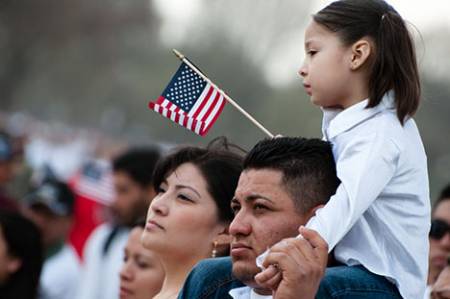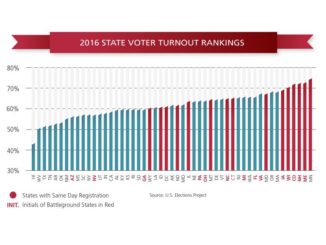
by Ronald Brownstein
Loudly, unmistakably, and irreversibly, the Next America announced its electoral arrival this week—years ahead of schedule.
This election will likely be remembered not only as a political but also a cultural and a social milestone in which the United States suddenly (and for many people, shockingly) realized it was a very different place than it once was.
From every direction, social and demographic change was the big story of the results. The key to President Obama’s solid Electoral College victory was his advantage among the growing population of nonwhite voters. That allowed Obama to win comfortably despite a historic rush toward Mitt Romney among white voters, especially older ones. Romney, in fact, ran about as well as any Republican challenger ever has among white voters, and he still captured only 206 Electoral College votes, pending the final count in Florida.
Down another track, the massive millennial generation continued to enlarge its influence on American politics. Millennials ticked up from 18 percent of the electorate in 2008 to 19 percent this year and once again provided Obama an overwhelming (if slightly reduced from four years ago) three-fifths of their votes. The results marked a milestone, as well, in American attitudes toward gays and lesbians: Tuesday saw the first election ever of an openly gay senator (Democrat Tammy Baldwin in Wisconsin) and the first time voters have approved a ballot initiative authorizing gay marriage. That happened not in one state but in three.
Obama’s continuing strength among minorities and young people allowed him to withstand erosion in the third pillar of the “coalition of the ascendant” that lifted him in 2008: college-educated whites. Compared with 2008, Obama lost ground not only among college-educated white men but also college-educated white women—although he still ran much better with the latter than with any other segment of the white electorate.
The coalition of minorities, young people, and just enough college-educated whites powered Obama’s success in many states, especially Sun Belt states such as Florida and Virginia, where he faced resounding rejection by working-class whites. But in the critical Midwest battlegrounds of Iowa, Ohio, and Wisconsin—where there are not enough of those “ascendant” voters to win—Obama repelled Romney’s challenge with a message of economic populism that attracted enough of the working-class whites who anchored the party’s coalition from the New Deal through the Great Society. In that way, Obama married just enough of the new and old Democratic coalitions to win.
Each of the key groups in Obama’s coalition of the ascendant is growing in society—which means that they will provide an even greater advantage to Democrats over time unless Republicans start winning more of them. “When you have a younger generation with a different set of ideas, and a changing demographic in the country, there’s going to be a tipping point; and during that tipping point, the two sides are roughly at parity,” says Morley Winograd, a senior fellow at the Democratic advocacy group NDN and coauthor with Michael Hais of two books on the millennial generation. “But at some point, that parity goes away and the direction becomes very clear.… We think this coalition is not only ascendant but will be dominant.”
ROLE REVERSAL
Compared with the resounding victories of many other reelected presidents, Obama’s triumph was hardly commanding. It more resembled George W. Bush’s razor-thin reelection in 2004. Obama’s share of the vote declined in all but six states. He became the first elected president since Andrew Jackson in 1832 to see his share of the popular vote decline after four years. And depending on the final count, Obama’s margin of victory, measured as a share of the popular vote, could replace Bush’s 2004 margin as the smallest ever for a reelected president.
Yet at least as striking was Obama’s ability to win at all in such a slow economic recovery, just two years after the intense ideological backlash to his first two years powered the GOP to historic congressional gains in 2010. The election underscored advantages in both the popular and the Electoral College votes that Democrats have consolidated since Bill Clinton’s first election in 1992. That campaign now stands, in retrospect, as the unmistakable beginning of a Democratic-leaning era in presidential politics.
With Obama’s victory, Democrats have quietly won the popular vote in five of the six presidential elections since 1992. That matches the Republican record of winning the popular vote in five of the six elections from 1968 to 1988. (Democrats generally won by smaller margins and had the asterisk election of 2000, when Al Gore lost the Electoral College.) Obama became the first Democrat since Franklin Roosevelt to attract more than 50 percent of the vote in consecutive elections.
The fact that he did so while losing white voters so decisively underscored both his achievement and the social change that the result encapsulated. Before the election, I argued that Obama’s formula for success could be reduced to an equation of 80/40. So long as minorities represented at least 26 percent of voters (their share in 2008), Obama could amass a national majority by winning 80 percent of nonwhite voters and only 40 percent of whites. In fact, pending final adjustments in the exit poll, he hit that mark almost precisely, winning 80 percent of minorities and 39 percent of whites. Obama carried 93 percent of African-Americans, 73 percent of Asian-Americans, 71 percent of Hispanics, and 58 percent of all other racial and ethnic minorities, the exit polls found. He held most of his 2008 margins in white-collar suburban counties with large minority populations such as Florida’s Hillsborough, Virginia’s Henrico, and Ohio’s Franklin.
The president’s performance among whites was far more tenuous. Obama won only 42 percent of college-educated white voters, well down from his 47 percent last time; before Tuesday, the Democrats’ share of the vote among college-educated whites had not declined in any election since 1980. (Even college-educated white women preferred Romney, 52 percent to 46 percent.) Obama nationally won only 36 percent of the vote among working-class whites, the poorest performance for any Democratic nominee since Walter Mondale in 1984. Obama retreated from his 2008 margins both in predominantly white white-collar suburbs (such as Jefferson in Colorado and Montgomery in Pennsylvania) and blue-collar counties (such as Michigan’s Macomb and Wisconsin’s Marathon).
The cumulative effect was striking. In 2008, Obama lost whites by 12 percentage points (55 percent to 43 percent), becoming the first nominee to win the White House while losing whites by double digits. In his reelection, he shattered that record with a 20-point margin.
HARD QUESTIONS
Those results left Republicans facing uncomfortable questions. Romney’s 59 percent showing among whites exceeded the 56 percent that Ronald Reagan won in 1980, matched the 59 percent that George H.W. Bush captured in 1988, and approached the 60 percent that Dwight Eisenhower took in 1952. Those were previously the best three showings for a Republican challenger among white voters. Each of them produced an electoral- and popular-vote landslide for the GOP. Yet for Romney, that share proved insufficient.
No Republican presidential nominee has won more than 50.8 percent of the popular vote since 1988. That’s largely because the party has remained almost completely dependent on whites for its support in a rapidly diversifying country. Romney, like John McCain in 2008, relied on whites for nearly 90 percent of his votes in a country with a 40 percent nonwhite population. Romney may have sealed his fate when the words “self-deportation” left his lips during a Florida primary debate. “We are in a position now where we have to—through differences in policy, differences in tone, and differences in candidates—reach out [to minorities] in a way we’ve never reached out before,” says veteran GOP pollster Whit Ayres. “Or we will not be successful as a national party.”
After these results, the big question facing the GOP is whether it can improve its performance among minorities, especially Hispanics, without returning to George W. Bush’s support for immigration reform that provides a pathway to citizenship for those living here illegally. That policy shift would face impassioned resistance from conservatives. “Looks like a brawl coming soon,” says longtime GOP strategist Mike Murphy. “The question is: Will the party base accept these facts, since they chose to ignore similar facts after Obama’s election four years ago?”
At the same time, the election also confirmed the reversal of roles in the competition for 270 Electoral College votes. From 1968 to 1988, Republican nominees dominated the Electoral College so thoroughly that analysts spoke of a GOP lock. But with Obama’s victory, Democrats have now won 18 states—the “blue wall”—for at least the past six consecutive elections. That’s the most states Democrats have won consecutively for that often since the formation of the modern party system in 1828.
Those 18 blue-wall states (joined by the District of Columbia) now offer 242 Electoral College votes. So long as Democrats hold all of them, Republicans must navigate an extremely narrow and unforgiving pathway to reach a majority.
By contrast, while defending the blue wall, Obama besieged two types of swing states in the Rust Belt and the Sun Belt—and ultimately captured most of both. His success proved that his Sun Belt breakthroughs in 2008, which built on movement toward the Democrats earlier in the decade, were not onetime flukes but the result of systemic demographic forces that have reconfigured the partisan balance of states that leaned reliably Republican from the 1970s until the beginning of this century.
Obama carried Colorado, Nevada, and Virginia; he leads in Florida and remained highly competitive in North Carolina, despite very weak numbers among white voters (especially working-class ones) in all of those states. That weakness was especially profound in the Southeastern states where many working-class whites are also evangelical Christians. But in Colorado, Nevada, and Virginia, Obama captured about half of the college-educated women (he won just over two-fifths of them in Florida). And in all four states, he benefited from huge margins among minority voters; in both Florida and Nevada, the minority share of the vote compared with 2008 increased by 5 percentage points, a stunning increase over one cycle and a testament to the Obama campaign’s registration and mobilization efforts.
In the Rust Belt, the story was very different. Rising minority turnout boosted Obama in Michigan and Ohio, and he carried about half or more of college-educated white women in Iowa, Ohio, and Wisconsin. But in those states, the key to his success was his ability to perform slightly above his national average among blue-collar white men and well above those levels among blue-collar white women. Obama won just under half of those women in Ohio and over half of them in Iowa and Wisconsin. That strength was rooted in the popularity of the auto bailout, an improving economy—and, perhaps above all, the emotional power (in a region scarred by decades of plant closing) of his campaign’s portrayal of Mitt Romney as a corporate raider who shut down factories while enriching himself.
Romney’s meager Electoral College vote haul continued a glum streak for the Republican Party. No GOP nominee since 1988 has carried more than the 286 Electoral College votes that George W. Bush won in 2004. Romney won just 20 percent of the available Electoral College votes outside the South (defined as the 11 states of the Old Confederacy plus Kentucky and Oklahoma). That’s just below the party’s average of 21.1 percent from 1992 to 2008, the smallest share of non-Southern Electoral College votes the party has captured in any five-election sequence since its founding in 1856. Demographically and regionally, the Republicans today are effectively competing for a narrower band of voters than the Democrats, at least in presidential campaigns. And demography offers no respite from those pressures.
“That 28 percent [minority-vote share of the electorate] will be 31 percent probably in 2016, and then it will be 34,” notes Matt Barreto, a founder of Latino Decisions, a polling firm that specializes in Hispanic voters. To win future elections, Republicans will need to either improve their minority performance or win even higher percentages of whites. “So it’s either going to get scarier in terms of those huge racial divides,” he says, “or the Republicans are going to have to sit up and say, ‘How can we cut into the Latino, African-American, and the Asian-American vote?’ ”
This article appeared in the National Journal.



